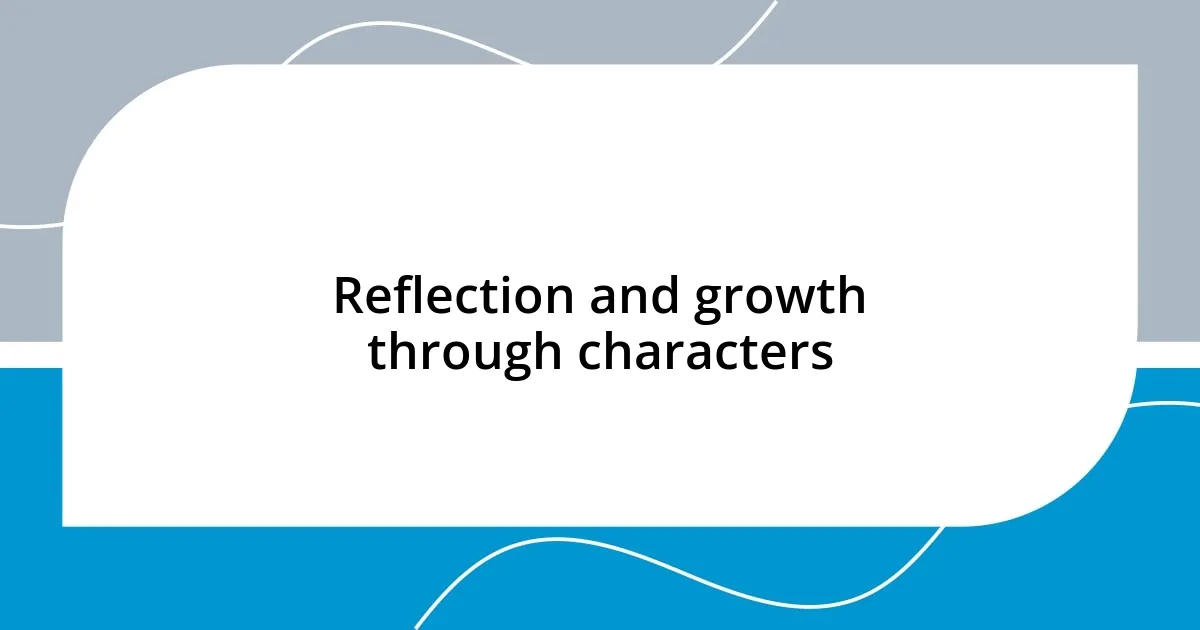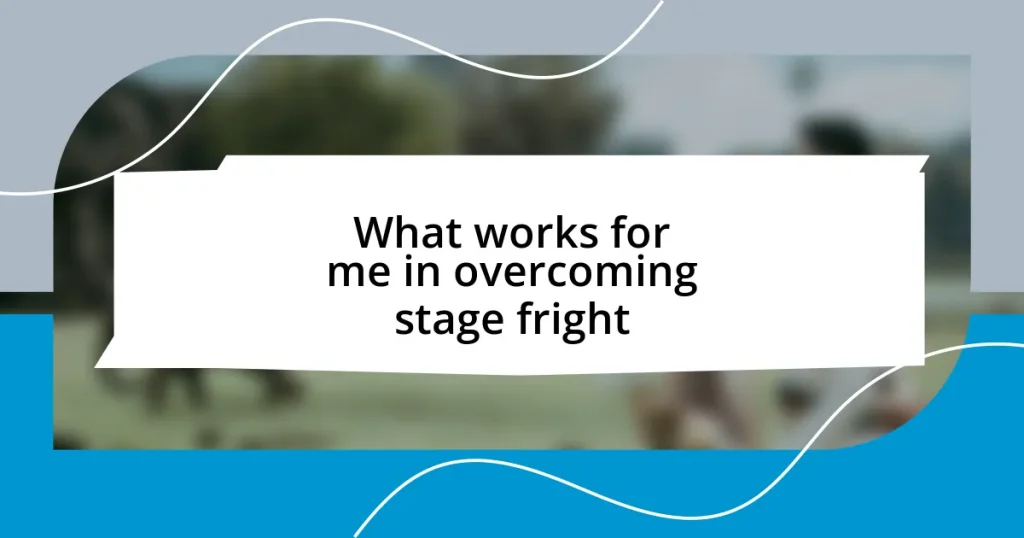Key takeaways:
- Character development enhances relatability through growth and transformation, allowing readers to reflect on their own experiences.
- Dynamic relationships and personal struggles create emotional investment and investment in character arcs, making narratives engaging.
- Utilizing techniques like backstory and conflict adds depth to characters, revealing their complexities and driving the plot forward.
- Real-life examples of personal transformation highlight the universal theme of growth, often paralleling fictional character journeys.

Understanding character development
Character development is the process through which a character evolves and grows throughout a narrative. I recall a time when I was deeply invested in a book series where the protagonist faced immense struggles, forcing me to wonder: how could someone be so resilient? It’s fascinating to see how experiences, conflicts, and relationships shape a character’s decisions and growth.
As I reflect on characters like Elizabeth Bennet from “Pride and Prejudice,” I’m reminded of how multifaceted personalities can be. Her journey from initial prejudices to profound self-awareness resonates with many of us. Have you ever found yourself changing your perspective after a significant event? That shift in understanding is at the heart of character development.
Moreover, I’ve noticed that the complexities of character traits—flaws and strengths—play a crucial role in creating meaningful arcs. Think about a time when you made a mistake and learned from it. Characters who stumble and rise again feel real and relatable. In my experience, this authenticity not only connects readers but also invites them to reflect on their growth, making the narrative all the more powerful.

Importance of character arcs
Character arcs are essential because they bring depth and relatability to narratives. I remember being captivated by a character who started off selfish and grew into a selfless hero. That transformative journey illuminated not only the character’s path but also aspects of my own life—making me reconsider moments when I’ve been a bit too self-centered. Isn’t it fascinating how stories reflect our own growth?
Another key aspect is that character arcs create emotional investment. When I read about a character overcoming obstacles, I find myself cheering them on, feeling every setback intensely because I’ve faced my own challenges. I recall binge-watching a series, completely invested in a character’s moral dilemmas. Those moments kept me on the edge of my seat, proving how important well-crafted character arcs are in keeping readers engaged.
Finally, character arcs often serve as mirrors to society’s values and struggles. For instance, watching a character confront their biases made me reflect on my own learned behaviors. This connection fosters empathy, weaving a thread between the reader and the broader human experience. So, in what ways do you see yourself mirrored in your favorite characters’ journeys?
| Importance | Impact on Audience |
|---|---|
| Growth and Transformation | Encourages self-reflection |
| Emotional Engagement | Builds investment in the story |
| Societal Mirrors | Fosters empathy and understanding |

Techniques for developing characters
One effective technique for developing characters is to use backstory. When I crafted my own stories, I took time to explore each character’s past, digging deep into their history, motivations, and relationships. This allowed me to understand what drives them and how they react to conflict. It’s like peeling an onion—each layer reveals something crucial about their identity. Remember, a character’s past doesn’t just inform their decisions; it brings a richness that makes them relatable.
Another powerful method is to create dynamic relationships between characters. I once wrote a story where a fierce rivalry transformed into a deep friendship. As these characters interacted, their evolving connection showcased vulnerability and growth. I found that these moments provided a fertile ground for character development. Some techniques to consider include:
- Conflict: Use internal and external conflicts to push characters out of their comfort zones.
- Dialogue: Let characters express their thoughts and feelings through conversations, revealing their true selves.
- Goals and Flaws: Define clear ambitions for your characters, paired with imperfections that challenge their paths.
- Transformation Scenes: Highlight key moments that lead to significant changes in character perspectives or behavior.
Through these techniques, I’ve seen how defining moments resonate deeply with readers, sparking connections that keep them invested in the journey. The exploration of character through relationships often mirrors our own experiences, making the fictional world feel all too real.

Tools for character analysis
Analyzing characters effectively requires the right tools, and one of my favorites is the use of character questionnaires. These detailed prompts encourage me to dig deep into a character’s psyche, asking questions about their dreams, fears, and defining moments. I remember spending hours developing a character by filling out their history—each answer revealing a new layer I hadn’t considered before.
Another invaluable tool for character analysis is the use of relationship mapping. This visual approach allows me to see how characters connect with one another. I often create diagrams to track their interactions, motivations, and conflicts. It’s a bit like playing chess; understanding each piece’s role and how they influence the game can significantly enrich the overall story. Have you ever mapped out a character’s relationships? I can’t tell you how eye-opening it is!
Finally, I often turn to narrative arcs and character development charts. They help me visualize how a character evolves throughout the story. I recall sketching a graph for a protagonist who started as apathetic but, through various trials, blossomed into a leader. Seeing this progression on paper confirmed the importance of intentional growth in storytelling. It’s amazing how a simple chart can illuminate the emotional journey and help maintain consistency in character growth.

Applying character development in writing
Applying character development in writing is an exciting and often transformative process. When I first began integrating characters into my stories, I was amazed by how their development influenced the plot. For instance, there was a time when I had a character who was initially timid and indecisive. As I allowed them to face challenges, I witnessed their evolution into a bold leader. Have you ever noticed how characters can shift not just their actions but the entire narrative? It’s thrilling to see those connections form on the page.
I also discovered that throwing characters into varied scenarios can reveal hidden aspects of their personality. In one of my stories, I placed a seemingly mild-mannered librarian in the middle of a chaotic festival. What started as a simple task quickly unraveled, leading to unexpected bravery. These moments are like little revelations that help both the reader and writer understand the essence of a character. I often find myself asking, “What if?” and then watching as the story takes unexpected turns.
Moreover, I’ve learned to pay great attention to the small details in my characters’ lives, such as their quirks and habits. This is where authenticity shines through. For example, I once created a character who compulsively organized everything around them. This seemingly trivial detail not only provided comic relief but also mirrored their need for control amidst chaos. Don’t you think that even the smallest traits can speak volumes about a character’s inner world? In my experience, these nuances serve as powerful tools to enhance relatability and depth.

Real life character development examples
One of the most profound examples of character development I’ve witnessed in real life is through individuals overcoming personal adversity. Take my friend Sam, for instance. He struggled with severe anxiety for years, making it nearly impossible for him to speak in public. After deciding to attend a support group and work through his fears, he gradually transformed from a shy person who avoided crowds to someone who now confidently leads workshops. How powerful is that kind of change? It’s inspiring to see someone break free from their limitations.
Another striking case I can recall is that of a former colleague, Janet, who shifted from a corporate career to pursue her passion for art full-time. Initially, she seemed trapped in the monotony of office life, always speaking about her regret of not following her dreams. When she finally took the leap to create a gallery, she blossomed. Watching her embrace vulnerability not only changed her perspective but also impacted everyone around her—her joy was contagious! Have you ever witnessed such a significant transformation?
Lastly, I think about the younger generation and their growth through activism. I’ve seen teenagers shift from apathy to passionate advocates for change, sparked by issues close to their hearts—like climate change or social justice. One young activist I met during a conference shared how a single experience at a protest awakened her sense of purpose. The fire in her voice and determination in her eyes showcased a complete character transformation. It’s incredible to think how our world is influenced by people willing to grow beyond their comfort zones. Have you ever felt inspired by a transformative journey like that? It’s a reminder of the resilience within us all.

Reflection and growth through characters
Seeing characters grow through reflection is a beautiful process that often mirrors my own experiences. For example, I remember crafting a character who faced deep insecurity because of past failures. As I allowed her to confront her fears, I felt a personal connection to her journey. What surprised me was how her introspection led not only to her growth but also to mine—I started to evaluate the areas in my own life where I, too, held back. Have you ever found yourself growing alongside a character?
In another instance, a character of mine, who was stuck in a monotonous life, began to explore his latent creative passions. It was as if I was witnessing a part of myself unfold on the page. I felt the same fear of stepping out of my comfort zone, and it encouraged me to take art classes I had long hesitated to join. Isn’t it fascinating how characters can act as catalysts for our own self-discovery? Their journeys often challenge me to dig deeper into my aspirations and confront my limitations.
Reflecting on the struggles of a character grappling with trust issues truly resonated with me. Putting her through a series of betrayals, I saw not only the pain but also the resilience that emerged from her vulnerability. I remember my own moments when I hesitated to trust others, fearing the hurt that could follow. Yet, crafting her journey reminded me of the beauty in allowing myself to be vulnerable. Doesn’t it sometimes feel as though characters are guides for us, leading us toward our personal growth?
















